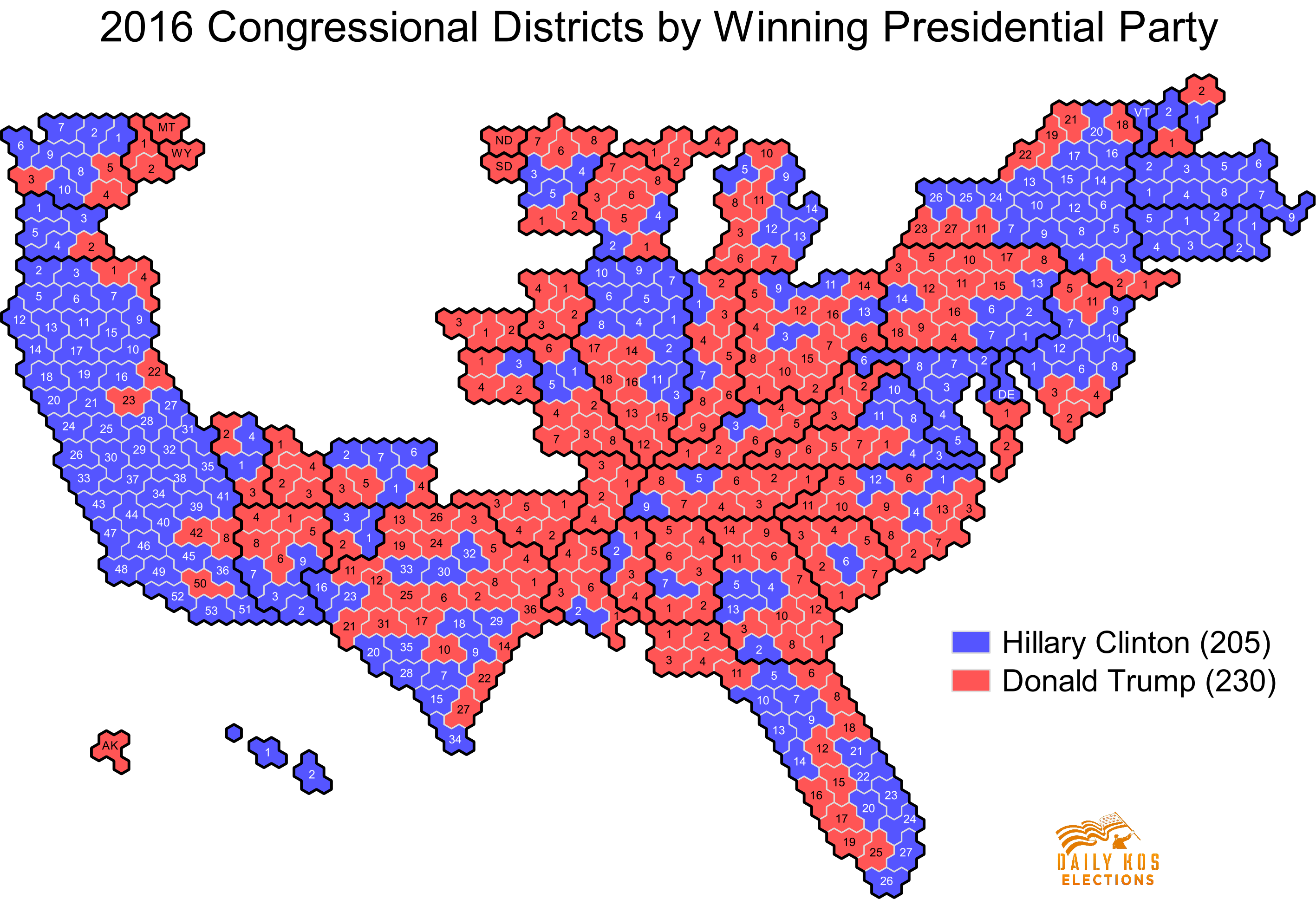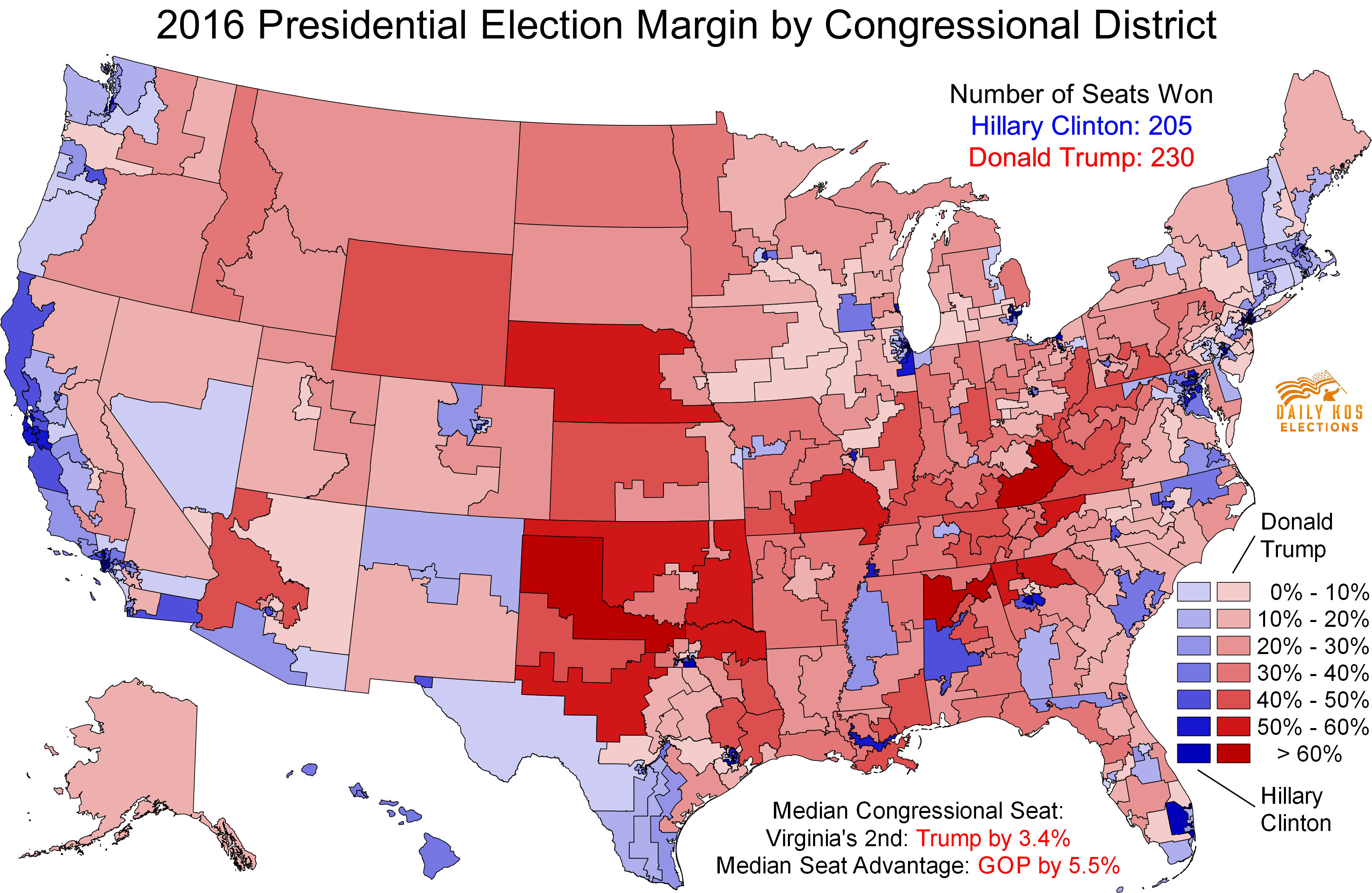Daily Kos Elections has been working to calculate the 2016 presidential election results by congressional district, and thanks in large part to the tireless efforts of Jeff Singer, we finally have the numbers for all 435 congressional districts. You can find our calculations for 2016 and both 2012 and 2008 in this post. Be sure to check out our comprehensive 115th Congress guide, which has presidential and congressional results for every district and state, along with member details and district demographics.
Despite losing the national popular vote by 2.1 percent, Donald Trump carried 230 congressional districts and Hillary Clinton just 205, as shown on the map above (see here for a larger version). We’ll take a much more thorough look at the presidential stats by district below the fold with several maps and graphs. You can also find our full series of even more maps and analysis here, including on how the House and presidential results compare.
One thing you might notice when looking at traditional district maps is how they tend to obscure geographically compact urban districts and overemphasize rural districts with low population density. To compensate for that, we have also created cartograms where each district is equally sized to give you a better sense of proportions. The cartogram below displays the same data as the map of the winning presidential party at the top of this story, but there’s a whole lot more blue when urban districts aren’t overshadowed.
 Click to enlarge
Click to enlarge
Overall, Trump won 25 more districts than Clinton carried, which is largely a result of the Republican advantage in control over the redistricting process. Maps with 55 percent of congressional districts were drawn to favor Republicans and just 10 percent for Democrats. Consequently, it shouldn’t be surprising that Trump carried most districts.
 Click to enlarge — Cartogram version
Click to enlarge — Cartogram version
The above map illustrates which districts flipped between the parties at the presidential level between 2012 and 2016. Overall, Clinton captured 15 districts that Mitt Romney carried, but Trump flipped 21 seats that Obama had won, for a net decrease of six districts voting Democratic between the two elections. Most of the Romney-Clinton seats were located in the Sun Belt, while most of the Obama-Trump districts were situated in the Northeast and Midwest.
 Click to enlarge — Cartogram version
Click to enlarge — Cartogram version
The map pictured above illustrates the presidential election margin itself by district. Clinton’s best performance was in New York’s 15th District, home to Democratic Rep. José Serrano, where she defeated Trump by 93.8 percent to 4.9 percent, or an 88.9 percent margin. That district is located in the Bronx and is the least-white district in the nation, at only around 3 percent of the population.
Trump’s best district depends on how you measure it. He won his highest vote share in Republican Rep. Robert Aderholt’s northern Alabama 4th District, where he prevailed by 80.3 points to 17.4 percent. However, Trump notched his greatest margin of victory in Republican Rep. Mac Thornberry’s 13th District in Texas’ panhandle, where he won by 79.9 percent to 16.9 percent, a 63-point margin.
The most closely divided district in the country was Democratic Rep. Peter DeFazio’s southwestern Oregon-based 4th District, which Clinton carried 46.1 percent to 46.0, a difference of just 0.1 percent and 554 votes. The next-closest district was Pennsylvania’s 8th, home to freshman Republican Rep. Brian Fitzpatrick and located in the suburbs northeast of Philadelphia, where Trump won by 48.2 percent to 48.0 percent, a margin of 0.2 points and 922 votes. Astoundingly, the 8th was also the narrowest Republican win in 2012, when Mitt Romney defeated Barack Obama by just 49.4 points to 49.3 percent.

This histogram graphs every district’s presidential margin from most Democratic to least Democratic—or in other words, from Clinton’s best margin to Trump’s highest margin. The one in the middle is the median district, where half the districts would be more Democratic and the other half would be less Democratic. In 2016, that was Virginia’s 2nd District, located in suburban Virginia Beach and home to freshman Republican Rep. Scott Taylor, where Trump prevailed by 48.8 percent to Clinton’s 45.4 percent for a margin of 3.4 points.
We can get a sense of how biased the districts are nationally by comparing that median margin to the national result, which Clinton won by 2.1 percent. Consequently, that 5.5 percent disparity in Trump’s favor between the overall result and the median district indicates a strong pro-Republican bias. Clinton would have theoretically needed to win the national popular vote by 5.5 percent to carry a bare majority of districts if every seat swung her way by the same margin.
 Click to enlarge — Cartogram version
Click to enlarge — Cartogram version
The map above displays how the 2016 presidential margin changed from 2012, with Trump improving on Romney’s performance in red districts and Clinton exceeding Obama’s margin in blue districts. Overall, Trump improved on Romney’s margin by 1.8 percent even though both Republicans still lost the national popular vote.
Utah Republican Rep. Jason Chaffetz’s 3rd District saw the biggest swing of any seat thanks to Romney doing unusually well with his fellow Mormons in 2012 and Trump proving to be uniquely unpopular for a Republican with that usually conservative demographic, with many Mormons voting for independent Evan McMullin. Trump still won that Provo-based district by 47-24 over McMullin, with Clinton actually coming in third at just 23 percent. However, that represented an enormous 34.9 percent drop in the Republican margin over Democrats from 2012, when Romney demolished Obama 78-19.
Ohio Republican Rep. Bill Johnson’s 6th District saw the biggest shift toward Trump of any seat. He carried the southeastern Ohio district by a 69-27 landslide, a massive 30.1 percent shift in margin from Romney’s much more modest 55-33 win four years ago. That heavily white Appalachian district has one of the lowest education rates, with only 13 percent of white voters having a college degree, the fourth-smallest proportion of any district, and that demographic swung heavily toward Trump.
As shown in the histogram above, Trump outran Romney’s performance in 248 districts, while Clinton exceeded Obama’s standing in the other 187. An astonishing 119 districts saw a shift of more than 10 percent in margin from 2012, while an outright majority of 242 districts experienced a swing of at least five points between one party or the other.
The above scatter plot graphs a comparison of the 2016 and 2012 presidential results by district, with the 2016 Democratic margin on the X-axis and Team Blue’s 2012 result on the Y-axis. Overall, the two results were extremely strongly correlated with each other (for statistics nerds, the R² was 0.93). What this means is that, for as much as pundits talked of 2016 being a realigning election, Trump nonetheless improved on Romney’s margin across a very wide range of districts.
These presidential election results by congressional district are important because in our polarized age of low ticket-splitting, they are an extremely strong predictor of performance at the congressional level. As shown below, just 35 districts split their tickets in 2016, with 12 districts having voted for Trump and electing a House Democrat, while just 23 districts supported Clinton but chose a Republican representative.
 Click to enlarge — Cartogram version
Click to enlarge — Cartogram version
We’ll take a deeper look at how the House election results in each district compared to the presidential result in our next post.


